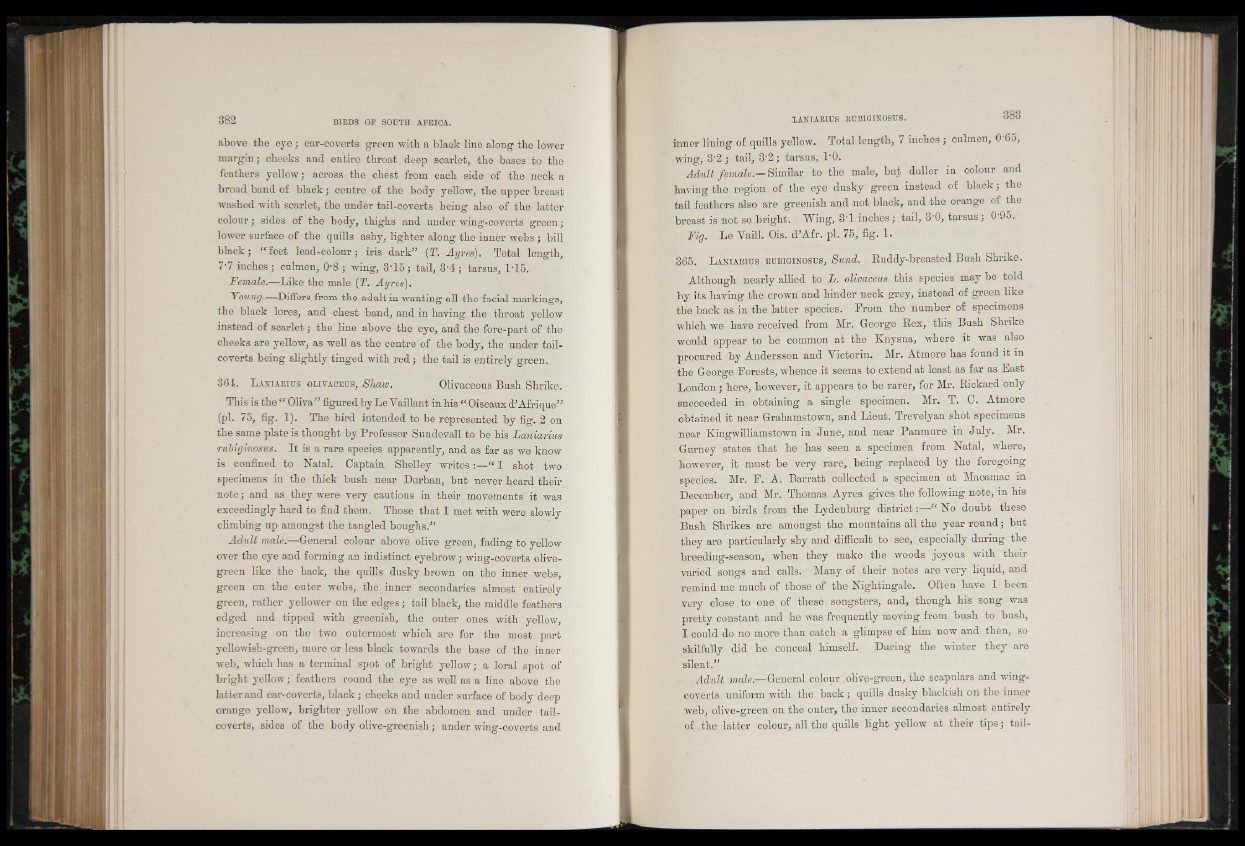
above the eye; ear-coverts green with a blaok line along the lower
margin; cheeks and entire throat deep scarlet, the bases to the
feathers yellow; across the chest from each side of the neck a
broad band of black; centre of the body yellow, the upper breast
washed with scarlet, the under tail-coverts being also of the latter
colour ; sides of the body, thighs and under wing-coverts green;
lower surface of the quills ashy, lighter along the inner webs ; bill
black; "feet lead-colour; iris dark” (T. Ayres). Total length,
7*7 inches; culmen, 0'8 ; wing, 3-15; tail, 3'4; tarsus, T15.
Female.—Like the male (37. Ayres).
Young.—Differs from the adult in wanting all the facial markings,
the black lores, and chest band, and in having the throat yellow
instead of scarlet; the line above the eye, and the fore-part of the
cheeks are yellow, as well as the centre of the body, the under tail-
coverts being slightly tinged with red ; the tail is entirely green.
364. L a n ia r iu s olivaceus, Shaw. Olivaceous Bush Shrike.
This is the " Oliva” figured by Le Vaillant in his “ Oiseaux d’Afrique”
(pi. 75, fig. 1). The bird intended to be represented by fig. 2 on
the same plate is thought by Professor Sundevall to be his Laniarius
rubiginosus. It is a rare species apparently, and as far as we know
is confined to Natal. Captain Shelley writes:—" I shot two
specimens in the thick bush near Durban, but never heard their
note; and as they were very cautious in their movements it was
exceedingly hard to find them. Those that I met with were slowly
climbing up amongst the tangled boughs.”
Adult male.—General colour above olive green, fading to yellow
over the eye and forming an indistinct eyebrow; wing-coverts olive-
green like the back, the quills dusky brown on the inner webs,
green on the outer webs, the inner secondaries almost entirely
green, rather yellower on the edges; tail black, the middle feathers
edged and tipped with greenish, the outer ones with yellow,
increasing on the two outermost which are for the most part
yellowish-green, more or less black towards the base of the inner
web, which has a terminal spot of bright yellow; a loral spot of
bright yellow; feathers round the eye as well as a line above the
latter and ear-coverts, black ; cheeks and under surface of body deep
orange yellow, brighter -yellow on the abdomen and under tail-
coverts, sides of the body olive-greenish; under wing-coverts and
inner lining of quills yellow. Total length, 7 inches ; culmen, 0'65,
wing, 3‘2; tail, 3'2; tarsus, l ’O.
Adult female.— Similar to the male, but duller in colour and
having the region of the eye dusky green instead of black; the
tail feathers also are greenish and not black, and the orange of the
breast is not so bright. Wing, 3'1 inches; tail, 3 0, tarsus; 0 95.
Fig. Le Vaill. Ois. d’Afr. pi. 75, fig. 1.
365. L a n ia r iu s ru b igin o su s , Sund. , Buddy-breasted Bush Shrike.
Although nearly allied to L. olivaceus this species may be told
by its having the crown and hinder neck grey, instead of green like
the back as in the latter species. Prom the number of specimens
which we have received from Mr. George Rex, this Bush Shrike
would appear to be common at the Knysna, where it was also
procured by Andersson and Yictorin. Mr. Atmore has found it in
the George Forests, whence it seems to extend at least as far as Bast
London ; here, however, it appears to be rarer, for Mr. Rickard only
succeeded in obtaining a single specimen. Mr. T. 0. Atmore
obtained it near Grahamstown, and Lieut. Trevelyan shot specimens
near Kingwilliamstown in June, and near Panmure in July. Mr.
Gurney states that he has seen a specimen from Natal, where,
however, it must be very rare, being replaced by the foregoing
species. Mr. F. A. Barratt collected a specimen at Maoamac in
December, and Mr. Thomas Ayres gives the following note, in his
paper on birds from the Lydenburg d i s t r i c t “ No doubt these
Bush Shrikes are amongst the mountains all the year round; but
they are particularly shy and difficult to see, especially during the
breeding-season, when they make the woods joyous with their
varied songs and calls. Many of their notes are very liquid, and
remind me much of those of the Nightingale. Often have I been
very close to one of these songsters, and, though his song was
pretty constant and he was frequently moving from bush to bush,
I could do no more than catch a glimpse of him now and then, so
skilfully did he conceal himself. During the winter they are
silent.”
Adult male.—General colour olive-green, the scapulars and wing-
coverts uniform with the back ; quills dusky blackish on the inner
web, olive-green on the outer, the inner secondaries almost entirely
of the latter colour, all the quills light yellow at their tips; tail